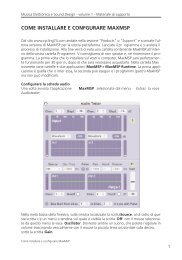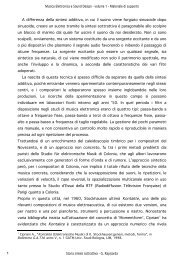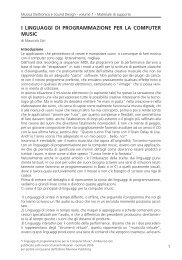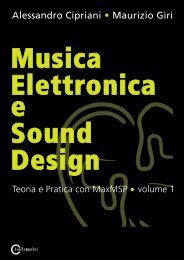programming with max/msp - Virtual Sound
programming with max/msp - Virtual Sound
programming with max/msp - Virtual Sound
Create successful ePaper yourself
Turn your PDF publications into a flip-book with our unique Google optimized e-Paper software.
Chapter 2P - Additive and vector synthesis<br />
2.1 FIXED SPECTRUM ADDITIVE SYNTHESIS<br />
To start things off, let’s create a patch for producing harmonic sounds in<br />
Max/MSP using additive synthesis, <strong>with</strong> Figure 2.12 of the theory chapter as<br />
our implementation guide. The diagram in that figure shows 10 oscillators,<br />
all summed using a mixer, and so we will begin <strong>with</strong> 10 cycle~ objects that<br />
will furnish the 10 sine waves, each producing a frequency which is an integer<br />
multiple of the fundamental (in order to be harmonic). To calculate the<br />
frequency values needed, we will simply multiply the frequency of the fundamental<br />
by the first 10 integers. The resulting patch is shown in Figure 2.1<br />
(02_01_additive.<strong>max</strong>pat).<br />
Fig. 2.1 The file 02_01_additive.<strong>max</strong>pat<br />
The number box at the top of the patch is used to set the fundamental frequency<br />
for the entire patch, which is then passed to the 9 * operators using<br />
successive integers to produce harmonic frequencies that are multiples of the<br />
fundamental. The frequency of the fundamental and of the frequencies being<br />
produced by these multipliers can be viewed in the 10 number boxes below,<br />
which are themselves connected to as many cycle~ objects. These, in turn,<br />
are connected to signal multipliers (*~) that rescale their outputs. Normally the<br />
amplitude of a signal produced by cycle~ will have a peak value of 1, and<br />
for this reason the value given to each multiplier serves to directly reflect the<br />
relative amplitude of each harmonic (for example, 1.0 ∙ 0.5 = 0.5). The signal<br />
multipliers enable each harmonic to have its own distinct amplitude, determined<br />
by the value fed into its multiplier. Given that we have 10 oscillators, 10 values<br />
completely specify the amplitudes to be used.<br />
from “Electronic Music and <strong>Sound</strong> Design” Vol. 1 by Alessandro Cipriani and Maurizio Giri<br />
© ConTempoNet 2010 - All rights reserved<br />
1T<br />
233







